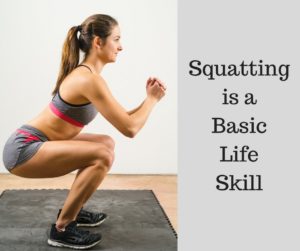
If physical therapists were given a dollar every time that someone told us that they were told “not to squat”, we would all have a consistent source of some extra pocket money. The fact that so many people receive this advice is a pet peeve of mine, and of many of my peers as well, I am sure.
Squatting is a fundamental human movement – one that we humans need to be able to perform throughout our lifetimes. At the most basic level, regardless of our age, we expect to sit. This requires squatting to lower our bottoms to our chairs. Hopefully, then we also expect to get up from sitting. This requires us to ‘un-squat’, if you will, to push ourselves up to a standing position. Getting into and out of cars requires squatting. Retrieving items from the floor requires squatting. Even more foundationally, we utilize squatting when getting on and off of the commode. Being told not to squat thus equates to being told not to try to independently accomplish an array of normal movements – all of which are integral to healthy, independent functioning in society.
Squatting is also a basic component of exercise and recreation. The running motion can thought of as essentially a series of repeated 1-legged squats, performed with alternating legs. Jumping and landing movements involve squats. Any activity that involves propelling the body forward and/or decelerating the body when it is in motion requires muscles that can be trained to perform better via some sort of squat. Do you want to hike? Dance? Play basketball? Ski? To do these things with good mechanics and without pain, you should be able to squat.
I hope that what people really mean when they tell others not to squat is something more along the lines of “don’t squat with pain.” Even that statement should come along with the recommendation that the person they are speaking to should seek help figuring out why they are not currently able to squat successfully. That is where your physical therapist comes in.
Squatting is actually a fairly tricky and complex skill. Successfully accomplishing a squat requires that a lot of things are going well in the body. Multiple joints – including those In the ankles, knees, hips, and spine – need to have sufficient mobility to move the body through the range of the squat. A multitude of muscles need to have sufficient strength, as well as the ability to efficiently work together, to adjust and support the body’s posture throughout the movement. Balance and coordination are involved in squatting, to maintain body alignment during the activity. Because of the complexity of the squatting movement, people have difficulty squatting for different reasons. Your physical therapist can assess your squatting form and help you to pinpoint why you are having trouble. And then you and your physical therapist can work together to fix the issues that are preventing you from squatting successfully. Isn’t that a better solution than to just try to avoid making the squatting movement ever again?!
Another common off-shoot of the advice to “not squat” is often that people are told that “squatting will wear out the joints”. This is also incorrect. Our bodies are made to move, and made to move in an infinite variety of ways. If we stop moving, we lose the ability to move, and this causes problems – from joint stiffness and loss of muscle mass to many more fundamental declines in physiological processes, such as blood circulation, oxygen transport, and lymphatic system removal of body toxins. (Check out this link for a list of many common undesirable effects of true loss of movement – as might occur as a result of spending lots of time in bed due to significant illness or injury.) In the case of squatting, if we do not require that our bodies perform this movement, then we gradually lose the ability to accomplish this movement. Losing the life skill of squatting typically occurs either because our joints lose the capacity to move through their normal range of movement, or because our muscles lose the strength and coordination to accomplish the activity. This really is a “use it or lose it” situation. Contrary to protecting our joints, avoiding movement can hasten decline in joint function. If you are unable to squat successfully – it may be that you have an existing joint problem. Why not treat the problem by working with your physical therapist? Physical therapy can help to ensure that joints are moving properly, with appropriate alignment, so as to avoid any further wear and tear and to enable the body to heal.
At Symmetry, we have seen patients with all sorts of health histories successfully regain the ability to comfortably squat. Some have been significantly overweight. Some have had considerable arthritis or other degenerative change in their joints and cartilage. Some have had long-term pain related to a variety of muscular disorders. Some are very old. Some are young, but have been unable to take their recreational activities or sports to the level that they desire because attempts to increase activity intensity have caused pain. Some are of any age and are typically comfortable during their daily activities, but for known or unknown reasons have started to have pain with movement. All of these individuals have learned how to adjust their squatting form to allow efficient and pain free movement.
We encourage everyone to squat, or to keep squatting, or to figure out how to squat more successfully. Please don’t accept guidance to abandon this fundamental human movement!
